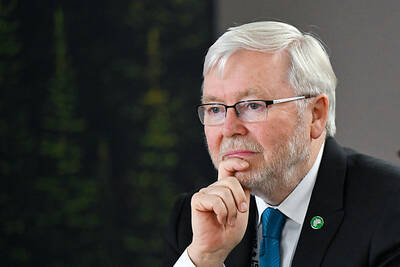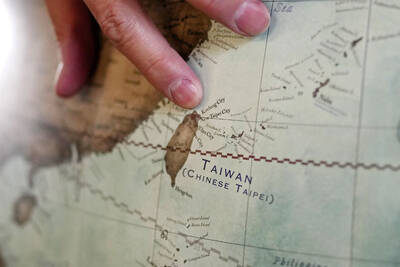Amid the rotting trash, shards of bricks and floor tiles are the only evidence of the homes that once packed into the Cambodian capital's Dey Krahom neighborhood, which is slated for demolition.
But a few dozen families are refusing to leave this slum, located on a wedge of once worthless property that is now part of a multi-million-dollar development scheme.
Their standoff with authorities has put them on the front line of an increasingly violent conflict over land in Cambodia that has seen dozens killed and tens of thousands evicted from their homes over the past few years.
Impoverished Cambodia is in the midst of a building boom that has caused land prices to skyrocket across the country.
Realtors estimate that the cost of prime pieces of property in Phnom Penh can top US$3,000 per square meter, a six-fold increase from eight years ago.
Even the vast swathes of wasteland, where the city's poorest have lived for years in squalid camps, are up for grabs.
It is here, rights groups say, that the human cost of this development is being counted in the loss of homes and jobs.
"There is this unprecedented development boom in Phnom Penh, but on the other hand there's more lawlessness, more landlessness," said an activist with a legal aid organization that has worked extensively with the victims of landgrabbing.
"The people who are losing out are the poor people, despite the fact that they have certain rights," he said, not wanting to be named.
After years of complete breakdown, Cambodia's land titling system is in disarray and doubts over ownership -- in Dey Krahom and elsewhere -- are often at the heart of evictions.
While villagers often claim to have some legal title to their properties, developers and the government insist that most of these families are nothing more than squatters and say their removal is necessary as Cambodia lurches out of the chaos of the post-war years.
In their place, Cambodia's leaders -- trying to propel their battered country towards prosperity -- have envisioned vast complexes of modern office towers and luxury shopping, condominiums and public parks.
"There are absolutely no unlawful and forcible evictions in Cambodia," the Foreign Ministry said in a statement earlier this month, responding to accusations by the rights group Amnesty International that the government was pushing people from their land illegally.
"Cambodia in some cases has to re-establish public and social order, such as in the case of turning the streets into market places, living on the sidewalks and in the parks, and illegally occupying state land," the ministry said.
Although many families in Dey Krahom have voluntarily left, taking a payout of several thousand dollars each from developers, others are holding out for more money and refusing to abandon their homes.
"We just want to get a fair price," said Keo Navann, an articulate woman in her early 40s who has emerged as a de facto spokesperson for those threatened with eviction.
Around her Dey Krahom is gradually disappearing -- large, litter-filled gaps fill the spaces in between the remaining shacks, which stand like lonely sentinels against the developer's construction equipment parked nearby.
"Developers are offering some people US$4,300 for their land, but this amount is not acceptable when they can sell it for US$3,000 a square meter," Keo Navann said.
The standoff turned dangerous last year when villagers in Dey Krahom clashed several times with police and security guards working for developers.
The violence escalated last month as security guards, escorting a bulldozer to Dey Krahom, began hurling rocks at residents trying to block their path to the village.
This strip of land fronting the Bassac River has been the scene of conflict in the past. Two years ago, authorities pushed thousands from slumland across the road from Dey Krahom.
The pre-dawn eviction to a remote resettlement site 22km away was one of the largest single forced moves from Phnom Penh since the communist Khmer Rouge evacuated the capital's population to the countryside after seizing power in 1975.

NEXT GENERATION: The four plants in the Central Taiwan Science Park, designated Fab 25, would consist of four 1.4-nanometer wafer manufacturing plants, TSMC said Taiwan Semiconductor Manufacturing Co (TSMC, 台積電) plans to begin construction of four new plants later this year, with the aim to officially launch production of 2-nanometer semiconductor wafers by late 2028, Central Taiwan Science Park Bureau director-general Hsu Maw-shin (許茂新) said. Hsu made the announcement at an event on Friday evening celebrating the Central Taiwan Science Park’s 22nd anniversary. The second phase of the park’s expansion would commence with the initial construction of water detention ponds and other structures aimed at soil and water conservation, Hsu said. TSMC has officially leased the land, with the Central Taiwan Science Park having handed over the

AUKUS: The Australian Ambassador to the US said his country is working with the Pentagon and he is confident that submarine issues will be resolved Australian Ambassador to the US Kevin Rudd on Friday said that if Taiwan were to fall to China’s occupation, it would unleash China’s military capacities and capabilities more broadly. He also said his country is working with the Pentagon on the US Department of Defense’s review of the AUKUS submarine project and is confident that all issues raised will be resolved. Rudd, who served as Australian prime minister from 2007 to 2010 and for three months in 2013, made the remarks at the Aspen Security Forum in Colorado and stressed the longstanding US-Australia alliance and his close relationship with the US Undersecretary

‘WORLD WAR III’: Republican Representative Marjorie Taylor Greene said the aid would inflame tensions, but her amendment was rejected 421 votes against six The US House of Representatives on Friday passed the Department of Defense Appropriations Act for fiscal 2026, which includes US$500 million for Taiwan. The bill, which totals US$831.5 billion in discretionary spending, passed in a 221-209 vote. According to the bill, the funds for Taiwan would be administered by the US Defense Security Cooperation Agency and would remain available through Sept. 30, 2027, for the Taiwan Security Cooperation Initiative. The legislation authorizes the US Secretary of Defense, with the agreement of the US Secretary of State, to use the funds to assist Taiwan in procuring defense articles and services, and military training. Republican Representative

TAIWAN IS TAIWAN: US Representative Tom Tiffany said the amendment was not controversial, as ‘Taiwan is not — nor has it ever been — part of Communist China’ The US House of Representatives on Friday passed an amendment banning the US Department of Defense from creating, buying or displaying any map that shows Taiwan as part of the People’s Republic of China (PRC). The “Honest Maps” amendment was approved in a voice vote on Friday as part of the Department of Defense Appropriations Act for the 2026 fiscal year. The amendment prohibits using any funds from the act to create, buy or display maps that show Taiwan, Kinmen, Matsu, Penghu, Wuciou (烏坵), Green Island (綠島) or Orchid Island (Lanyu, 蘭嶼) as part of the PRC. The act includes US$831.5 billion in